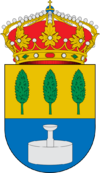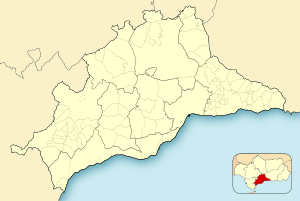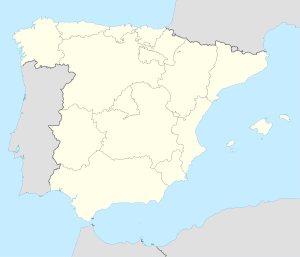Alameda, Andalusia facts for kids
Quick facts for kids
Alameda
|
|||
|---|---|---|---|
|
Municipality and town
|
|||
 |
|||
|
|||

Municipal location in Málaga Province
|
|||
| Sovereign state | |||
| Autonomous community | |||
| Province | |||
| Comarca | Antequera | ||
| Area | |||
| • Total | 25 sq mi (65 km2) | ||
| Population
(2018)
|
|||
| • Total | 5,366 | ||
| Time zone | UTC+1 (CET) | ||
| • Summer (DST) | UTC+2 (CEST) | ||
| Website | www.alameda.es | ||
Alameda is a charming town in southern Spain. It is located in the province of Málaga, which is part of the Andalusia region. The town is about 85 kilometers (53 miles) from the city of Málaga.
Alameda has a population of around 5,000 people. The people who live there are called Alamedanos or Lametanos. The town gets its name from a stream called Álamos, which flows through the area. A famous Spanish bandit, "El Tempranillo," is buried in Alameda.
The town sits north of Antequera, about 430 meters (1,410 feet) above sea level. It gets about 610 liters per square meter of rain each year. The average temperature is around 16°C (61°F). Alameda covers an area of about 65 square kilometers (25 square miles).
Contents
Discover Alameda
Where is Alameda?
The municipality of Alameda is the northernmost part of the Malaga province. It is mostly a flat area with a few small hills. The landscape is full of olive trees, similar to the nearby countryside of Cordoba and Seville.
A Look at History
Archaeological finds show that people have lived in the Alameda area for a very long time. Settlements have existed here since the Neolithic period.
Ancient Times
Around 208 B.C., during the time of Carthage, local people faced a Roman attack. To stay loyal to the Carthaginians, they bravely set fire to their own village. They chose to perish in the fire rather than surrender to the Romans.
During the Roman Empire, Alameda was a very important place. Three major Roman roads that led to the region of Hispania Baetica passed through the municipality. One of these old roads, called "la Real," still crosses the town today. You can see it from the Plaza of Spain to the Plaza de Andalucia.
Later Periods
Not much is known about Alameda's history between the Roman times and the 16th century. A small treasure from the Visigoths (a group of people who lived in Europe) dating back to the 6th century suggests there was a settlement here then.
In the 16th century, Alameda became part of the lands owned by the Marquess of Estepa. Because important roads connecting Granada, Málaga, and Seville crossed in this area, the Marquess decided to build a church. In 1663, the Immaculate Conception parish church was built. The town then grew around this church.
Modern History
Since the early 19th century, Alameda has been part of the province of Málaga.
In the Plaza de Andalucia, which is now the town's center, there is a special stone. It was placed in 1994. The stone remembers the first elected council of the town from June 27, 1931. This council had ordered the town clock bell to have the names of its members carved on it.
See also
 In Spanish: Alameda (Málaga) para niños
In Spanish: Alameda (Málaga) para niños






